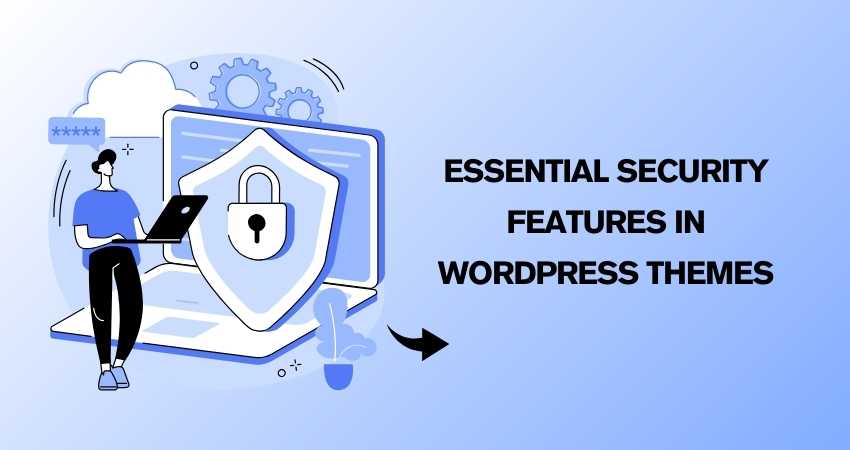WordPress, the ubiquitous content management system (CMS), powers over 40% of the web. Its popularity is mainly due to its flexibility, ease of use, and a vast ecosystem of themes and plugins. However, this widespread adoption also makes WordPress sites a prime target for malicious attacks. Therefore, ensuring robust security measures within WordPress themes is imperative for website owners and developers.
This article delves into the essential security features that WordPress themes should incorporate to safeguard websites against potential threats. To help you implement these features, we also recommend using the following security plugins or tools:
Here are some popular security plugins for WordPress
- Wordfence Security: Wordfence is one of WordPress‘s most widely used security plugins. It provides firewall protection, malware scanning, login security, and real-time threat defense.
- Sucuri Security: Sucuri Security offers website security solutions, including malware scanning, monitoring, and cleanup, as well as website firewall (WAF) protection. It helps to safeguard websites from various online threats.
- iThemes Security: Formerly known as Better WP Security, iThemes Security offers a suite of security tools such as malware scanning, file integrity checks, brute force protection, and vigorous password enforcement.
- All-In-One WP Security & Firewall: This plugin offers comprehensive security features, including firewall protection, login lockdown, database security, and user account monitoring. It provides an easy-to-use interface for enhancing WordPress security.
- SecuPress: SecuPress is a user-friendly security plugin that offers protection against brute force attacks, suspicious IP blocking, malware scanning, and security notifications. It also includes features for website hardening and security audits.
- BulletProof Security: BulletProof Security provides security measures like malware scanning, firewall protection, database backups, and login security. It includes features for both basic and advanced users to secure their WordPress sites.
- Shield Security: Shield Security offers a range of security features, including login protection, brute force prevention, IP blacklist, and file integrity monitoring. It focuses on simplicity and effectiveness in securing WordPress websites.
- Security Ninja: Security Ninja is a security plugin that performs over 50 security tests to identify vulnerabilities in WordPress installations. It provides actionable recommendations to help users strengthen their website’s security.
- Jetpack Security: Jetpack offers a suite of security features, including downtime monitoring, brute force protection, malware scanning, and secure authentication. It integrates seamlessly with WordPress websites and provides centralized security management.
- WP Security Audit Log: WP Security Audit Log keeps track of all changes and user activity on WordPress websites. It provides detailed logs and real-time alerts for monitoring user actions, helping administrators to maintain security and compliance.
Key Security Features in WordPress Themes
1. Code Quality and Regular Updates:
- High-quality code is the foundation of a secure WordPress theme. Themes developed following WordPress coding standards are less prone to vulnerabilities.
- Regular updates are crucial for patching security loopholes and keeping up with the latest WordPress core updates and security best practices.
2. Secure Authentication and Access Controls:
- Implementing secure authentication mechanisms like two-factor authentication (2FA) can prevent unauthorized access to the WordPress admin dashboard.
- Robust access controls ensure that only authorized users can perform specific actions within the theme, reducing the risk of unauthorized modifications or data breaches.
3. Cross-Site Scripting (XSS) Protection:
- XSS attacks are among the most common security threats WordPress sites face. Themes should sanitize and validate user inputs to prevent malicious scripts from being executed.
- Utilizing security headers such as Content Security Policy (CSP) can mitigate the risk of XSS attacks by restricting the sources from which resources can be loaded.
4. SQL Injection Prevention:
- SQL injection attacks exploit vulnerabilities in the database layer of a web application. WordPress themes should use prepared statements and parameterized queries to prevent malicious SQL injections.
- Exploiting user inputs and enforcing strict input validation are essential to thwart SQL injection attempts.
5. Cross-Site Request Forgery (CSRF) Protection:
- CSRF attacks trick authenticated users into unknowingly executing malicious actions on a website. Implementing nonce (number used once) verification in theme forms and actions can mitigate CSRF vulnerabilities.
- CSRF tokens should be unique per session and validated on the server side to prevent unauthorized actions.
6. Secure File Handling and Uploads:
- Themes should enforce strict file upload restrictions to prevent the execution of malicious scripts disguised as images or media files.
- Utilizing WordPress’s built-in functions for file handling and validation ensures that uploaded files undergo rigorous security checks before processing.
7. Data Encryption and HTTPS Support:
- Encrypting sensitive data such as user credentials, session tokens, and payment information is essential to protect against eavesdropping and data interception.
- Themes should support HTTPS protocol and encourage website owners to install SSL/TLS certificates to establish secure encrypted connections between the server and client browsers.
8. Role-Based Permissions and Privileges:
- Implementing granular role-based access control (RBAC) ensures that users are assigned appropriate permissions based on their roles and responsibilities.
- Limiting authorized users’ access to sensitive theme settings and functionality reduces the risk of unauthorized modifications or configurations.
9. Secure Theme Customization and Third-Party Integrations:
- Themes should provide secure mechanisms for customizations, such as child themes and theme hooks, to ensure that modifications do not compromise the site’s security.
- When integrating third-party services or plugins, themes should adhere to WordPress coding standards and conduct thorough security assessments to vet the integrity and security of external components.
Conclusion:
Security is paramount in the digital landscape, especially for WordPress websites vulnerable to cyber threats. As website owners and developers, you play a crucial role in fortifying your websites’ security posture by implementing these robust security features and best practices. WordPress themes can offer a secure foundation for building resilient and trustworthy websites in an increasingly hostile online environment by prioritizing code quality, regular updates, and comprehensive security measures.
